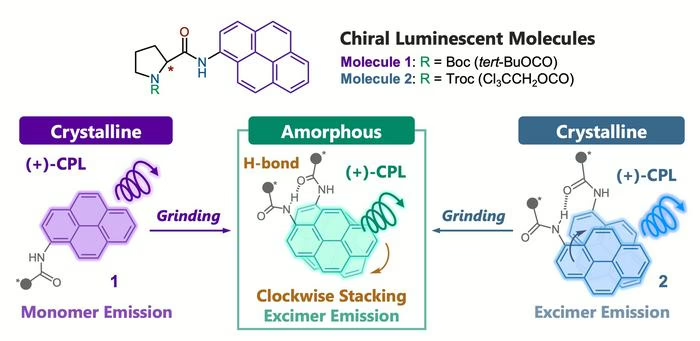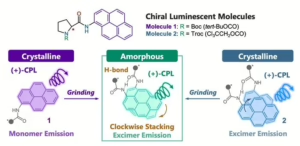Researchers at Yokohama National University have unveiled a new design for chiral molecules that emit circularly polarized luminescence (CPL), a discovery with significant implications for advanced 3D displays, biosensors, and secure printing applications.

The study describes how two specially designed pyrenylprolinamide compounds retain their unique light-emitting properties even after their crystalline structure is mechanically disrupted. Typically, grinding crystals into an amorphous state results in a substantial drop in CPL efficiency. However, in this breakthrough work, the compounds, one incorporating a tert-butoxycarbonyl (Boc) group and the other a 2,2,2-trichloroethoxycarbonyl (Troc) group, continue to exhibit robust CPL after undergoing such mechanical stress.
Both molecules are built around a chiral amino acid, which imparts a non-superimposable mirror image quality essential for directing the rotation of emitted light, and a pyrene unit, which facilitates both monomer and excimer emission. The key innovation lies in the molecular design that promotes hydrogen bonding between the stacked pyrene groups. This interaction preserves excimer emission, ensuring that the light maintains its circular polarization even when the well-ordered crystalline structure is lost.
The findings not only address a longstanding challenge in maintaining CPL efficiency following mechanical stimuli but also lay the groundwork for establishing general design principles for mechanochromic CPL materials. By demonstrating that properly engineered molecular interactions can counteract the usual decline in luminescence performance, this research opens the door to more reliable and durable materials for high-tech applications.
Looking forward, the next phase of work will focus on refining these design guidelines to enable the widespread implementation of switchable, solid-state CPL materials. Such advancements could lead to more sophisticated and secure display technologies as well as innovative methods for anti-counterfeiting measures in printed media.
Reference
S. Ito, S. Wakiyama, H. Chen, M. Abekura, H. Uekusa, R. Ikemura, Y. Imai, Angew. Chem. Int. Ed. 2025, e202422913. https://doi.org/10.1002/anie.202422913

